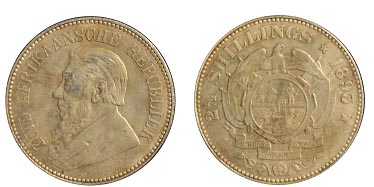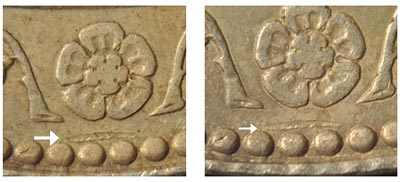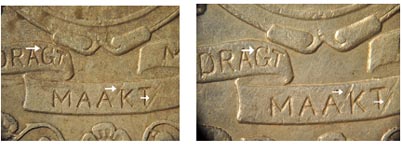Counterfeit Detection: Repeating Depression on a Pair of Counterfeit 1893 South Africa 2½ Shillings
Posted on 10/11/2010
Authenticators often look for characteristics (such as marks) that repeat on multiple coins to assist in identifying counterfeits. It is virtually impossible for two genuine coins to have marks in the exact same locations, so if two coins show identical abrasions there is a very good chance that they are fake. NGC recently received two 1893 South African 2½ shillings that showed a number of repeating depressions that helped prove these coins were counterfeit.
When counterfeiters make fakes, they frequently make a die using a genuine example. The details of this coin, including all of its marks and other imperfections, are then transferred onto the die or mold. The counterfeits that are subsequently struck will all show the exact same marks. While it is true that there is one genuine example that has all of these abrasions, every other coin that shows those flaws will be a fake. Depressions (a term used by authenticators to describe marks on counterfeits) that repeat on two or more coins are evidence that the coins are counterfeit.
 |
| 1893 South Africa 2½ Shillings, Second Example |
The two counterfeit 1893 South African 2½ shillings submitted to NGC possess many identical depressions. Rather than point out every flaw with these two coins, in this article we highlight two areas of the lower reverse that show particularly obvious marks. The first pair of magnified images shows a long depression below the flower that appears on both examples. The second set shows three prominent marks in the banner that are seen in the same areas on each coin.
 |
| Identical Mark at Lower Reverse |
 |
| Identical Marks on Motto on Reverse |
Repeating depressions are common features of counterfeits, and many of the ones that appear on different United States issues are well documented. Several counterfeit detection books show some of the most commonly seen fakes and what marks a numismatist should look out for. NGC also maintains its own internal database of these characteristics as they are identified.
Stay Informed
Want news like this delivered to your inbox once a month? Subscribe to the free NGC eNewsletter today!
